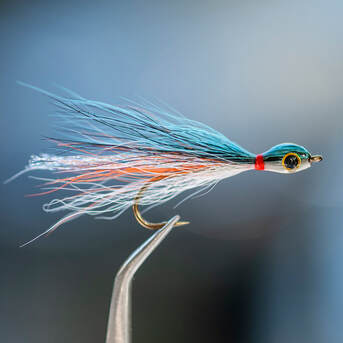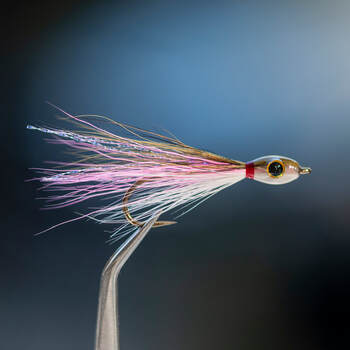Fly of the Month 11.21 - Thunder Creek Streamer
The original design of streamers evolved from attaching materials just behind the eye of the hook and building up the thread wraps to become the head. The thread could then be whipped finished, lacquered and painted with eyes of white or yellow and a center black pupil. Prior to painting eyes and protecting the threatened bird, a jungle cock feather was tied to each side giving the appearance of eyes in the cheek material.
Thunder Creek (the series)
Keith Fulsher, a fly fisherman from Eastchester, New York, tied flies for the renown Angler's Cove in Manhattan where he came into contact with Lew Oatman, another tier who contributed greatly to streamer design, and Alex Rogan, a descendant of the Scottish Rogans who were well established tiers involved in Atlantic salmon fly design. Essentially, Fulsher had the very best around him to learn all about designing and tying streamers.
In 1962, Fulsher started to experiment with constructing a streamer with a larger head that would more realistically imitate bait fish. He did not believe a thread head with painted eyes or jungle cock eyes was an appropriate representation of the large head of a minnow. Not satisfied with the streamers available at that time, he created a number of sparse and streamlined minnow imitations using a reversed bucktail.
Thunder Creek Series:
Thunder Creek Black Nose Dace
Thunder Creek Blueback Trout
Thunder Creek Brook Trout
Thunder Creek Brown Trout
Thunder Creek Rainbow Trout
Thunder Creek Golden Shiner
Thunder Creek Labrador Brook Trout
Thunder Creek Redfin Shiner
Thunder Creek Silver Shiner
Thunder Creek Smelt
Mary Orvis Marbury includes several reversed head flies in "Favorite Flies and Their Histories". Carrie Stevens used this design for saltwater flies. Fulsher's real innovation and contribution was the creation of a series of imitative flies that matched the form and coloration of local baitfish. He tested these patterns initially on Thunder Creek in northern Wisconsin, thus, the name Thunder Creek (TC).
Thunder Creek Blueback Trout
This style, which had been employed with other fly patterns, involved tying bucktail onto the hook shank behind the eye so that the tips projected forward of the hook eye. With a darker color on top and a lighter color on the bottom, the bucktail butts were then secured to the shank and wrapped to the eye. The free ends were bent back over the shank and secured so that they now projected beyond the hook bend resulting in a substantial head which allows for large sized eyes.
Fulsher’s reverse tied bucktails adds detail and allows for a variety of patterns to be tied with the method. (see book references listed below). The Blueback Trout Thunder Creek Minnow, comes from the book written in collaboration with David Klausmeyer and includes additional TC fly patterns for fresh and saltwater. It represents the fry of the endangered blueback trout of Maine.
The straight eye hooks can be tough to find. The head can be weighted with a few wraps of non-lead wire. The finish on the head can be done with UV resin, but epoxy or several coats of clear lacquer will also work.
Thunder Creek Blueback Trout
Fly of the Month 11.21
Fly Name: Thunder Creek Blueback Trout
Hook: Partridge CS5 #2-8, Gaelic Supreme Thunder Creek, Mustad 36620,
Daiichi 1750, 2370, TMC 939, Streamer 3-6xL, SE
Weight: Optional non-lead wire
Thread: White 8/0 (70-denier)
Flanks: Blue crystal flash & orange bucktail
Belly: White bucktail
Back: Blue & Black bucktail
Throat: Red paint
Eyes: Yellow paint with a dot of black paint
Coating: Solarez thin hard & Bone dry*
*Epoxy or several layers of clear lacquer may also be used
Tom Adams and Alen Baker
References:
Tying and fishing the Thunder Creek series – Keith Fulsher 1973 https://amzn.to/2DzpAr7
Thunder Creek Flies: Tying and Fishing the Classic Baitfish Imitations – Keith Fulsher and David Klausmeyer 2006 https://amzn.to/2KmA4vc
Thunder Creek Streamer
Note: The various imitations are easily achieved by changing the bucktail color selection and the process remains the same.
Recipe :
Hook : Streamer hook, straight eye, 3x or 4x, size 4,6,8,10,12
Thread : White 8/0
Body : Blue, Black, White, Orange bucktail with Krystal flash
Throat : Red thread
Eyes : Painted or stick on
Directions :
The original design of streamers evolved from attaching materials just behind the eye of the hook and building up the thread wraps to become the head. The thread could then be whipped finished, lacquered and painted with eyes of white or yellow and a center black pupil. Prior to painting eyes and protecting the threatened bird, a jungle cock feather was tied to each side giving the appearance of eyes in the cheek material.
Thunder Creek (the series)
Keith Fulsher, a fly fisherman from Eastchester, New York, tied flies for the renown Angler's Cove in Manhattan where he came into contact with Lew Oatman, another tier who contributed greatly to streamer design, and Alex Rogan, a descendant of the Scottish Rogans who were well established tiers involved in Atlantic salmon fly design. Essentially, Fulsher had the very best around him to learn all about designing and tying streamers.
In 1962, Fulsher started to experiment with constructing a streamer with a larger head that would more realistically imitate bait fish. He did not believe a thread head with painted eyes or jungle cock eyes was an appropriate representation of the large head of a minnow. Not satisfied with the streamers available at that time, he created a number of sparse and streamlined minnow imitations using a reversed bucktail.
Thunder Creek Series:
Thunder Creek Black Nose Dace
Thunder Creek Blueback Trout
Thunder Creek Brook Trout
Thunder Creek Brown Trout
Thunder Creek Rainbow Trout
Thunder Creek Golden Shiner
Thunder Creek Labrador Brook Trout
Thunder Creek Redfin Shiner
Thunder Creek Silver Shiner
Thunder Creek Smelt
Mary Orvis Marbury includes several reversed head flies in "Favorite Flies and Their Histories". Carrie Stevens used this design for saltwater flies. Fulsher's real innovation and contribution was the creation of a series of imitative flies that matched the form and coloration of local baitfish. He tested these patterns initially on Thunder Creek in northern Wisconsin, thus, the name Thunder Creek (TC).
Thunder Creek Blueback Trout
This style, which had been employed with other fly patterns, involved tying bucktail onto the hook shank behind the eye so that the tips projected forward of the hook eye. With a darker color on top and a lighter color on the bottom, the bucktail butts were then secured to the shank and wrapped to the eye. The free ends were bent back over the shank and secured so that they now projected beyond the hook bend resulting in a substantial head which allows for large sized eyes.
Fulsher’s reverse tied bucktails adds detail and allows for a variety of patterns to be tied with the method. (see book references listed below). The Blueback Trout Thunder Creek Minnow, comes from the book written in collaboration with David Klausmeyer and includes additional TC fly patterns for fresh and saltwater. It represents the fry of the endangered blueback trout of Maine.
The straight eye hooks can be tough to find. The head can be weighted with a few wraps of non-lead wire. The finish on the head can be done with UV resin, but epoxy or several coats of clear lacquer will also work.
Thunder Creek Blueback Trout
Fly of the Month 11.21
Fly Name: Thunder Creek Blueback Trout
Hook: Partridge CS5 #2-8, Gaelic Supreme Thunder Creek, Mustad 36620,
Daiichi 1750, 2370, TMC 939, Streamer 3-6xL, SE
Weight: Optional non-lead wire
Thread: White 8/0 (70-denier)
Flanks: Blue crystal flash & orange bucktail
Belly: White bucktail
Back: Blue & Black bucktail
Throat: Red paint
Eyes: Yellow paint with a dot of black paint
Coating: Solarez thin hard & Bone dry*
*Epoxy or several layers of clear lacquer may also be used
Tom Adams and Alen Baker
References:
Tying and fishing the Thunder Creek series – Keith Fulsher 1973 https://amzn.to/2DzpAr7
Thunder Creek Flies: Tying and Fishing the Classic Baitfish Imitations – Keith Fulsher and David Klausmeyer 2006 https://amzn.to/2KmA4vc
Thunder Creek Streamer
Note: The various imitations are easily achieved by changing the bucktail color selection and the process remains the same.
Recipe :
Hook : Streamer hook, straight eye, 3x or 4x, size 4,6,8,10,12
Thread : White 8/0
Body : Blue, Black, White, Orange bucktail with Krystal flash
Throat : Red thread
Eyes : Painted or stick on
Directions :
- Debarb and mount the hook in the vise. Tie in the thread and secure two or three eyelengths and let the bobbin hang.
- Select two or three strands of flash and tie in on top of the hook shank in the center of the length of the flash with two “x” wraps. Stroke back the flash and hold by trapping with your finger against the shank. Make three or four wraps of thread to trap the flash along the sides of the hook shank. Let the bobbin hang.
- Select a small amount of orange bucktail and trim from the tail. Clean the bucktail of all of the short and fuzzy fibers. Stack in hair stacker or align with your fingers. Tie in the bucktail on top of the hook shank with the tips facing toward the eye. Advance the thread in tight touching turns to just behind the eye. Use a minimum amount of thread wraps to prevent bulk. Once secure, check the length by folding back the bucktail. This length should extend past the hook bend by one or two hook gaps. Trim the excess ends of bucktail as necessary.
- Turn the hook over (rotate if you have a rotary vise) and repeat step 3 with white bucktail
- Turn the hook over (rotate if you have a rotary vise) and repeat step 3 with black bucktail
- Repeat step 3 with blue bucktail.
- Change thread to red and let the bobbin hang.
- There are several methods to the next step but this is simple and quick. Rotate the vise and select the white bucktail and stroke back from the eye along the hook shank and secure with two or three wraps maintaining the white along the shank without slipping around or onto the opposite side. If needed you can use a bodkin to separate the white bucktail from the color before folding back. Use slight or mild pressure on pulling back the hair to make it flat to the shank.
- Rotate the vise and repeat step 8 with black and then blue bucktail.
- The thread has not moved from the starting position, though it may have grown slightly in width. Make the final securing turns at the same spot and whip finish. Trim thread.
- Trim the krystal flash to about the same length as the bucktail.
- Use a UV coating to seal the head only. Start with a thicker blend and once cured add an eye of choice to each side. Once the eyes are in position use a thin UV coating to finish off the head.


